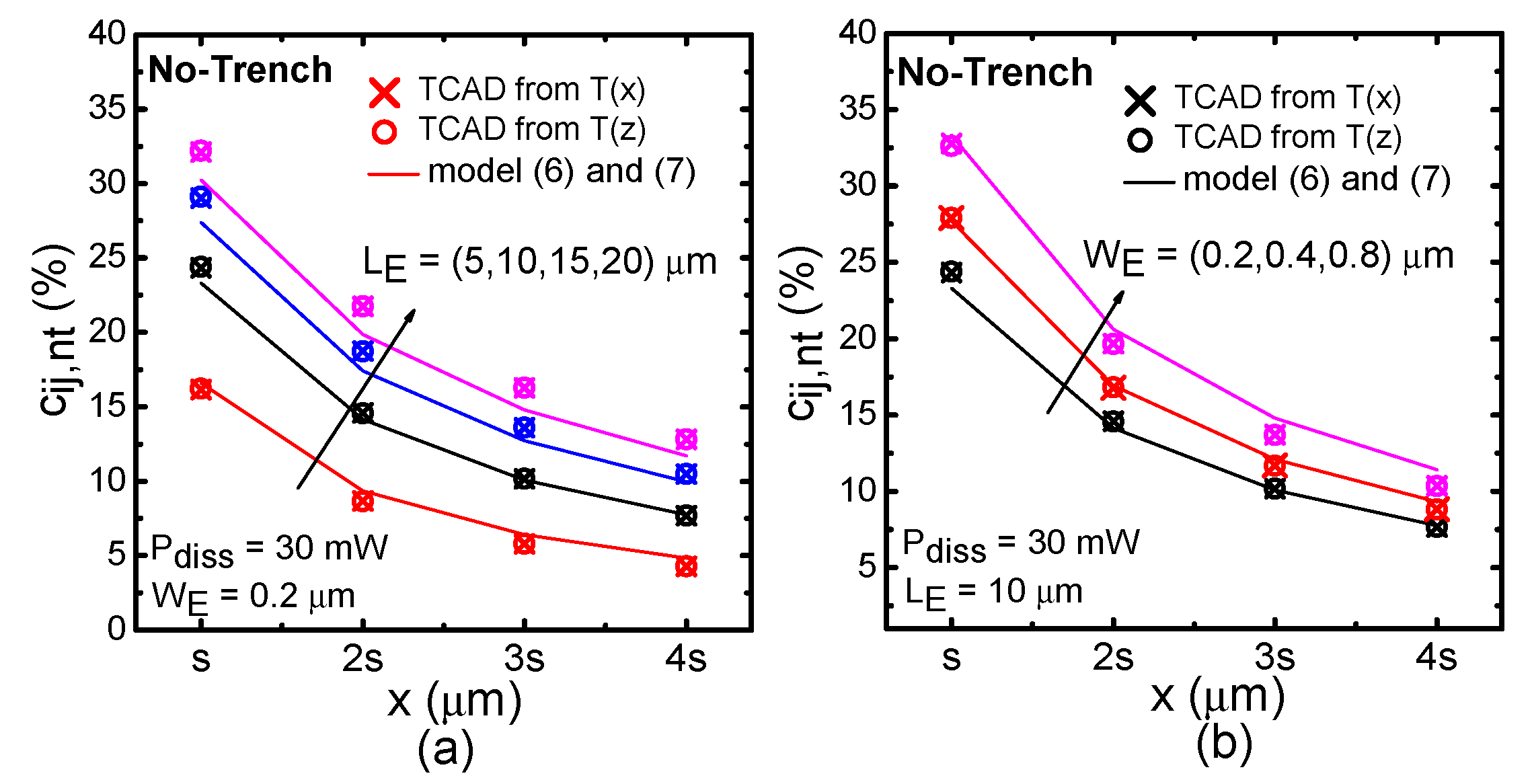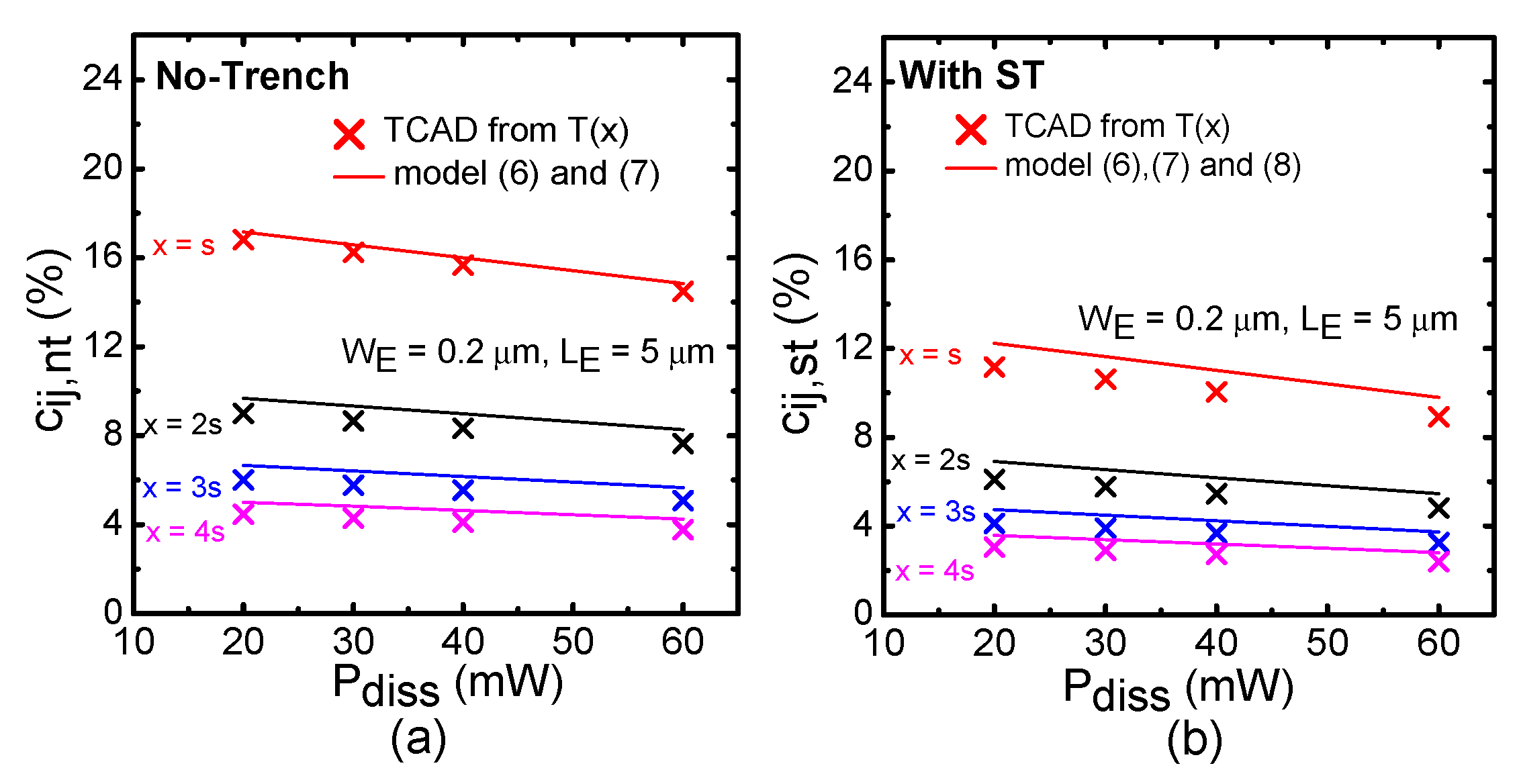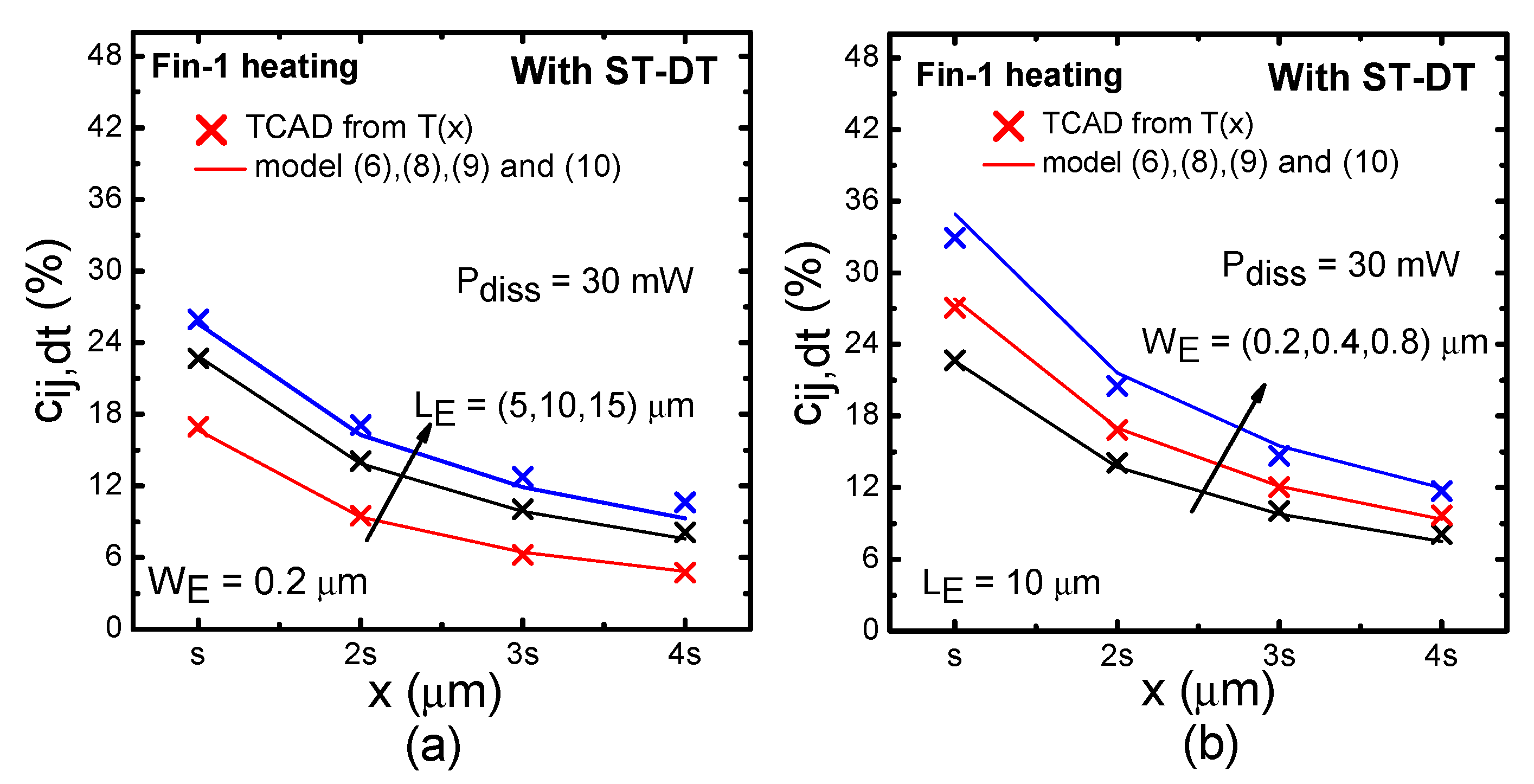Static Thermal Coupling Factors in Multi-Finger Bipolar Transistors: Part I—Model Development
Abstract
:1. Introduction
2. Model Formulation
2.1. Vertical Position-Dependent Temperature
2.2. Coupling Factor for Structures with No-Trench Isolation
2.3. Coupling Factor for Structures with Shallow Trench Isolation
2.4. Coupling Factor for Structures with Additional Deep Trench Isolation
3. Results and Discussion
4. Limitations and Future Scope
5. Conclusions
Author Contributions
Funding
Conflicts of Interest
References
- Harame, D.L.; Comfort, J.; Cressler, J.; Crabbe, E.; Sun, J.C.; Meyerson, B.; Tice, T. Si/SiGe epitaxial-base transistors. II. Process integration and analog applications. IEEE Trans. Electron Devices 1995, 42, 469–482. [Google Scholar] [CrossRef]
- Lachner, R. Towards 0.7 THz Silicon Germanium Heterojunction Bipolar Technology—The DOTSEVEN Project. ECS Trans. 2014, 64, 21–37. [Google Scholar] [CrossRef]
- Wilson, L. International Technology Roadmap for Semiconductors (ITRS) 2013. Available online: http://www.itrs2.net/2013-itrs.html (accessed on 14 July 2020).
- Chevalier, P.; Meister, T.; Heinemann, B.; Van Huylenbroeck, S.; Liebl, W.; Fox, A.; Sibaja-Hernandez, A.; Chantre, A. Towards THz SiGe HBTs. In Proceedings of the Bipolar/BiCMOS Circuits and Technology Meeting (BCTM), Atlanta, GA, USA, 9–11 October 2011; pp. 57–65. [Google Scholar]
- Joy, R.C.; Schlig, E. Thermal properties of very fast transistors. IEEE Trans. Electron Devices 1970, 17, 586–594. [Google Scholar] [CrossRef]
- Walkey, D.J.; Celo, D.; Smy, T.J.; Surridge, R.K. A thermal design methodology for multifinger bipolar transistor structures. IEEE Trans. Electron Devices 2002, 49, 1375–1383. [Google Scholar] [CrossRef]
- Smy, T.; Walkey, D.; Dew, S.K. A 3D thermal simulation tool for integrated devices–Atar. IEEE Trans. Comput.-Aided Des. Integr. Circuits Syst. 2001, 20, 105–115. [Google Scholar] [CrossRef]
- Synopsys. Sentaurus: Sentaurus Device User Guide, Release H-2013.03; Synopsys: Mountain View, CA, USA, 2013. [Google Scholar]
- Sahoo, A.K.; Fregonese, S.; Weiss, M.; Maneux, C.; Zimmer, T. A Scalable Model for Temperature Dependent Thermal Resistance of SiGe HBTs. In Proceedings of the Bipolar/BiCMOS Circuits and Technology Meeting (BCTM), Bordeaux, France, 30 September–3 October 2013; pp. 29–32. [Google Scholar] [CrossRef]
- Chakravorty, A.; D’Esposito, R.; Balanethiram, S.; Frégonèse, S.; Zimmer, T. Analytic Estimation of Thermal Resistance in HBTs. IEEE Trans. Electron Devices 2016, 63, 2994–2998. [Google Scholar] [CrossRef]
- Balanethiram, S.; Chakravorty, A.; D’Esposito, R.; Fregonese, S.; Céli, D.; Zimmer, T. Accurate modeling of thermal resistance for on-wafer SiGe HBTs using average thermal conductivity. IEEE Trans. Electron Devices 2017, 64, 3955–3960. [Google Scholar] [CrossRef] [Green Version]
- Yadav, S.; Chakravorty, A. A pragmatic approach to modeling self-heating effects in SiGe HBTs. IEEE Trans. Electron Devices 2017, 64, 4844–4849. [Google Scholar] [CrossRef]
- Balanethiram, S.; Chakravorty, A.; D’Esposito, R.; Fregonese, S.; Zimmer, T. An improved scalable self-consistent iterative model for thermal resistance in SiGe HBTs. In Proceedings of the Bipolar/BiCMOS Circuits and Technology Meeting (BCTM), New Brunswick, NJ, USA, 25–27 September 2016; pp. 150–153. [Google Scholar] [CrossRef] [Green Version]
- Lehmann, S.; Weiss, M.; Zimmermann, Y.; Pawlak, A.; Aufnger, K.; Schroter, M. Scalable compact modeling for SiGe HBTs suitable for microwave radar applications. In Proceedings of the Topical Meeting on Silicon Monolithic Integrated Circuits in RF Systems, Phoenix, AZ, USA, 17–19 January 2011; pp. 113–116. [Google Scholar] [CrossRef]
- Walkey, D.J.; Smy, T.J.; Dickson, R.G.; Brodsky, J.S.; Zweidinger, D.T.; Fox, R.M. Equivalent circuit modeling of static substrate thermal coupling using VCVS representation. IEEE J. Solid State Circuits 2002, 37, 1198–1206. [Google Scholar] [CrossRef]
- Zimmermann, Y. Modeling of Spatially Distributed and Sizing Effects in High-Performance Bipolar Transistors. Master’s Thesis, Chair Electron Devices Integrated Circuits, Technische Universität, Dresden, Germany, 2004. [Google Scholar]
- Weiss, M.; Sahoo, A.K.; Maneux, C.; Fregonese, S.; Zimmer, T. Mutual thermal coupling in SiGe:C HBTs. In Proceedings of the Symposium on Microelectronics Technology and Devices (SBMicro), Curitiba, Brazil, 2–6 September 2013; pp. 1–4. [Google Scholar] [CrossRef]
- Dwivedi, A.; Chakravorty, A.; D’Esposito, R.; Sahoo, A.K.; Fregonese, S.; Zimmer, T. Effects of BEOL on self-heating and thermal coupling in SiGe multi-finger HBTs under real operating condition. Solid State Electron. 2016, 115, 1–6. [Google Scholar] [CrossRef]
- Goh, G.; Kim, U.; Jeon, M.S.; Kim, J. A simple extraction method of thermal resistance in multifinger GaAs HBT. IEEE Trans. Electron Devices 2016, 63, 2620–2624. [Google Scholar] [CrossRef]
- Lehmann, S.; Zimmermann, Y.; Pawlak, A.; Schroter, M. Characterization of the static thermal coupling between emitter fingers of bipolar transistors. IEEE Trans. Electron Devices 2014, 61, 3676–3683. [Google Scholar] [CrossRef]
- Gupta, A.; Nidhin, K.; Balanethiram, S.; Yadav, S.; Chakravorty, A.; Fregonese, S.; Zimmer, T. Static Thermal Coupling Factors in Multi-FingerBipolar Transistors: Part II—Experimental Validation. J. Electron. 2020. submitted. [Google Scholar]
- Gao, G.B.; Ünlü, M.S.; Morkoc, H.; Blackburn, D.L. Emitter ballasting resistor design for, and current handling capability of AlGaAs/GaAs power heterojunction bipolar transistors. IEEE Trans. Electron Devices 1991, 38, 185–196. [Google Scholar] [CrossRef]
- Walkey, D.J.; Smy, T.J.; Macelwee, T.; Maliepaard, M. Compact representation of temperature and power dependence of thermal resistance in Si, Inp and GaAs substrate devices using linear models. Solid State Electron. 2002, 46, 819–826. [Google Scholar] [CrossRef]
- Chevalier, P.; Avenier, G.; Ribes, G.; Montagné, A.; Canderle, E.; Céli, D.; Derrier, N.; Deglise, C.; Durand, C.; Quémerais, T.; et al. A 55 nm triple gate oxide 9 metal layers SiGe BiCMOS technology featuring 320 GHz fT/370 GHz fmax HBT and high-Q millimeter-wave passives. In Proceedings of the 2014 IEEE International Electron Devices Meeting IEDM, San Francisco, CA, USA, 15–17 December 2014; pp. 3.9.1–3.9.3. [Google Scholar]
- Rieh, J.S.; Johnson, J.; Furkay, S.; Greenberg, D.; Freeman, G.; Subbanna, S. Structural dependence of the thermal resistance of trench-isolated bipolar transistors. In Proceedings of the Bipolar/BiCMOS Circuits and Technology Meeting (BCTM), Minneapolis, MN, USA, 1 October 2002; pp. 100–103. [Google Scholar] [CrossRef]
- Sahoo, A.K.; Fregonese, S.; Weis, M.; Malbert, N.; Zimmer, T. A Scalable Electrothermal Model for Transient Self-Heating Effects in Trench-Isolated SiGe HBTs. IEEE Trans. Electron Devices 2012, 59, 2619–2625. [Google Scholar] [CrossRef] [Green Version]
- Couret, M.; Fischer, G.; Frégonése, S.; Zimmer, T.; Maneux, C. Physical, small-signal and pulsed thermal impedance characterization of multi-finger SiGe HBTs close to the SOA edges. In Proceedings of the 2019 IEEE 32nd International Conference on Microelectronic Test Structures (ICMTS), Kita-Kyushu City, Fukuoka, Japan, 18–21 March 2019; pp. 154–159. [Google Scholar] [CrossRef] [Green Version]
- Mukherjee, C.; Couret, M.; Nodjiadjim, V.; Riet, M.; Dupuy, J.Y.; Fregonese, S.; Zimmer, T.; Maneux, C. Scalable Modeling of Thermal Impedance in InP DHBTs Targeting Terahertz Applications. IEEE Trans. Electron Devices 2019, 66, 2125–2131. [Google Scholar] [CrossRef] [Green Version]













© 2020 by the authors. Licensee MDPI, Basel, Switzerland. This article is an open access article distributed under the terms and conditions of the Creative Commons Attribution (CC BY) license (http://creativecommons.org/licenses/by/4.0/).
Share and Cite
Gupta, A.; Nidhin, K.; Balanethiram, S.; Yadav, S.; Chakravorty, A.; Fregonese, S.; Zimmer, T. Static Thermal Coupling Factors in Multi-Finger Bipolar Transistors: Part I—Model Development. Electronics 2020, 9, 1333. https://doi.org/10.3390/electronics9091333
Gupta A, Nidhin K, Balanethiram S, Yadav S, Chakravorty A, Fregonese S, Zimmer T. Static Thermal Coupling Factors in Multi-Finger Bipolar Transistors: Part I—Model Development. Electronics. 2020; 9(9):1333. https://doi.org/10.3390/electronics9091333
Chicago/Turabian StyleGupta, Aakashdeep, K Nidhin, Suresh Balanethiram, Shon Yadav, Anjan Chakravorty, Sebastien Fregonese, and Thomas Zimmer. 2020. "Static Thermal Coupling Factors in Multi-Finger Bipolar Transistors: Part I—Model Development" Electronics 9, no. 9: 1333. https://doi.org/10.3390/electronics9091333






